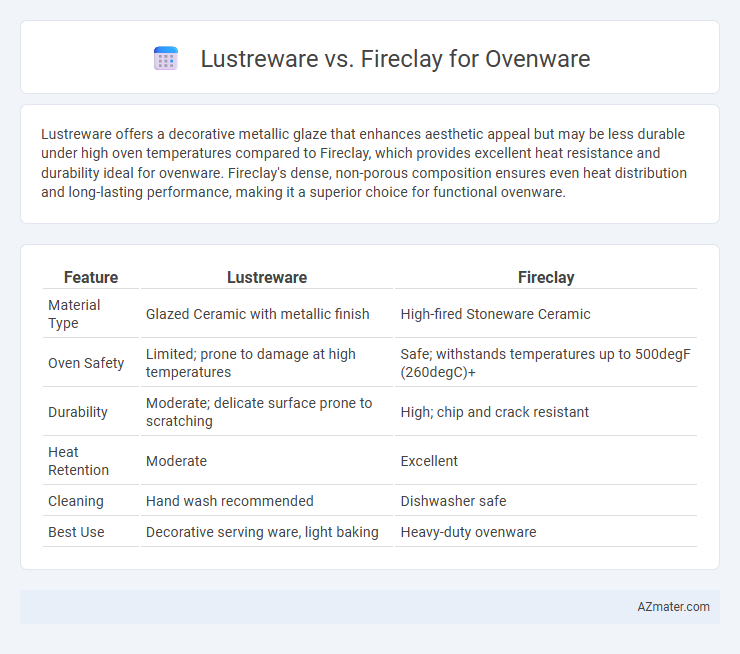Lustreware offers a decorative metallic glaze that enhances aesthetic appeal but may be less durable under high oven temperatures compared to Fireclay, which provides excellent heat resistance and durability ideal for ovenware. Fireclay's dense, non-porous composition ensures even heat distribution and long-lasting performance, making it a superior choice for functional ovenware.
Table of Comparison
| Feature | Lustreware | Fireclay |
|---|---|---|
| Material Type | Glazed Ceramic with metallic finish | High-fired Stoneware Ceramic |
| Oven Safety | Limited; prone to damage at high temperatures | Safe; withstands temperatures up to 500degF (260degC)+ |
| Durability | Moderate; delicate surface prone to scratching | High; chip and crack resistant |
| Heat Retention | Moderate | Excellent |
| Cleaning | Hand wash recommended | Dishwasher safe |
| Best Use | Decorative serving ware, light baking | Heavy-duty ovenware |
Introduction to Lustreware and Fireclay Ovenware
Lustreware ovenware features a distinctive metallic glaze that enhances heat reflection, providing even cooking and a visually striking finish ideal for artistic presentations. Fireclay ovenware, crafted from dense, durable clay fired at high temperatures, offers exceptional thermal shock resistance and superior heat retention for consistent baking results. Both materials are prized for their durability and functionality, but Lustreware emphasizes aesthetic appeal while Fireclay prioritizes robustness and heat distribution.
Material Composition: Lustreware vs Fireclay
Lustreware is typically made from porcelain or earthenware coated with a metallic glaze that creates an iridescent finish, while fireclay is a dense, refractory ceramic composed of natural clay minerals designed to withstand high temperatures. Fireclay's robust composition makes it highly durable and resistant to thermal shock, ideal for ovenware subjected to rapid temperature changes. Lustreware, though decorative and visually appealing, is less heat-resistant than fireclay, making fireclay the preferred material for functional ovenware requiring both strength and heat endurance.
Heat Resistance and Oven Safety
Lustreware ovenware features moderate heat resistance suitable for conventional baking temperatures but may crack under sudden temperature changes or extreme heat. Fireclay offers superior heat resistance due to its dense, vitrified composition, making it highly durable and safer for high-temperature oven use. Fireclay's thermal shock resistance reduces the risk of ovenware breakage, ensuring consistent performance during intense cooking conditions.
Durability and Longevity Comparison
Lustreware offers moderate durability with a decorative glaze that can chip or wear over time, making it less ideal for heavy oven use. Fireclay, composed of dense, non-porous ceramic, provides superior resistance to thermal shock and wear, ensuring excellent longevity for ovenware applications. The inherent strength of fireclay materials makes them more reliable for repeated high-temperature cooking compared to the more fragile surface of lustreware.
Design and Aesthetic Appeal
Lustreware offers a glossy, iridescent finish with vibrant metallic hues that create a vintage, eye-catching look ideal for decorative ovenware. Fireclay, on the other hand, features a matte, handcrafted appearance with earthy tones and natural textures, providing a rustic and artisanal aesthetic. Both materials enhance ovenware design but cater to distinct styles: Lustreware for bold elegance and Fireclay for organic charm.
Cooking Performance and Food Safety
Lustreware offers excellent heat retention and even cooking, making it ideal for consistent oven performance, while Fireclay provides superior thermal shock resistance and durability under high temperatures. Both materials are non-toxic and lead-free, ensuring food safety, but Fireclay's naturally dense composition enhances resistance to cracking and absorption, reducing bacterial contamination. Choosing between Lustreware and Fireclay depends on prioritizing either aesthetic appeal and heat conduction or long-term durability and hygiene in ovenware.
Ease of Cleaning and Maintenance
Lustreware features a glazed surface that is generally smooth and non-porous, making it relatively easy to clean after baking, though its decorative finishes may require gentle handling to prevent damage. Fireclay ovenware, known for its durable, vitrified ceramic composition, resists staining and chipping, enabling straightforward maintenance and often dishwasher-safe cleaning. Both materials offer reliable durability, but Fireclay tends to outperform Lustreware in ease of cleaning due to its more robust, less delicate surface.
Cost and Value for Money
Lustreware offers affordable ovenware options with vibrant glazing but tends to be less durable under high heat, impacting long-term value for money. Fireclay, made from dense, high-quality clay, provides superior heat resistance and durability, often justifying its higher initial cost through greater longevity and performance. Choosing between Lustreware and Fireclay depends on balancing upfront budget constraints against expected durability and sustained oven-safe usage.
Pros and Cons of Lustreware Ovenware
Lustreware ovenware offers a striking metallic glaze that enhances aesthetic appeal but can be prone to chipping and discoloration under high heat, limiting its durability for intensive oven use. Its non-porous surface resists stains and odors, making it easier to clean compared to Fireclay, which is generally more heat-resistant but less decorative. While Lustreware excels in style and moderate baking, Fireclay provides better thermal shock resistance and longevity for heavy-duty ovenware applications.
Pros and Cons of Fireclay Ovenware
Fireclay ovenware is highly durable and resistant to thermal shock, making it ideal for high-temperature cooking and baking compared to Lustreware, which may crack under sudden temperature changes. Its non-porous surface prevents staining and retains heat evenly, enhancing cooking performance and food safety. However, fireclay ovenware tends to be heavier and more expensive, potentially limiting its convenience and affordability for some users.

Infographic: Lustreware vs Fireclay for Ovenware
 azmater.com
azmater.com